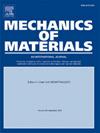An additive Mori–Tanaka scheme for elastic–viscoplastic composites based on a modified tangent linearization
IF 3.4
3区 材料科学
Q2 MATERIALS SCIENCE, MULTIDISCIPLINARY
引用次数: 0
Abstract
Mean-field modeling based on the Eshelby inclusion problem poses some difficulties when the non-linear Maxwell-type constitutive law is used for elasto–viscoplasticity. One difficulty is that this behavior involves different orders of time differentiation, which leads a long-term memory effect. One of the possible solutions to this problem is the additive interaction law. Generally, mean field models solely use the mean values of stress and strain fields per phase, while variational approaches consider the second moments of stresses and strains. It is seen that the latter approach improves model predictions allowing to account for stress fluctuation within the phases. However, the complexity of the variational formulations still makes them difficult to apply in the large scale finite element calculations and for non-proportional loadings. Thus, there is a need to include the second moments within homogenization models based on the additive interaction law. In the present study, the incorporation of the second moments of stresses into the formulation of the additive Mori–Tanaka model of two-phase elastic–viscoplastic material is discussed. A modified tangent linearization of the viscoplastic law is proposed, while the Hill–Mandel’s lemma is used to track the evolution of second moments of stresses. To study the model performance and efficiency, the results are compared to the full-field numerical calculations and predictions of other models available in the literature. Very good performance of the modified tangent linearization is demonstrated from these benchmarks for both monotonic and non monotonic loading responses.
基于改进切线化的弹粘塑性复合材料的加性Mori-Tanaka格式
当弹粘塑性采用非线性maxwell型本构律时,基于Eshelby包含问题的平均场建模存在一些困难。一个困难是,这种行为涉及不同的时间分化顺序,这导致了长期记忆效应。这个问题的一个可能的解决方案是加性相互作用定律。一般而言,均场模型只使用每相应力场和应变场的平均值,而变分方法则考虑应力和应变的第二矩。可以看出,后一种方法改进了模型预测,允许考虑阶段内的应力波动。然而,变分公式的复杂性仍然使其难以应用于大规模有限元计算和非比例加载。因此,有必要在基于加性相互作用律的均匀化模型中加入二阶矩。本文讨论了在两相弹粘塑性材料的加性Mori-Tanaka模型中加入应力第二矩的问题。提出了粘塑性规律的修正切线化方法,并利用Hill-Mandel引理跟踪应力二阶矩的演化。为了研究模型的性能和效率,将结果与文献中其他模型的全场数值计算和预测结果进行了比较。从这些基准测试中可以看出,改进的切线化方法对单调和非单调加载响应都有很好的性能。
本文章由计算机程序翻译,如有差异,请以英文原文为准。
求助全文
约1分钟内获得全文
求助全文
来源期刊

Mechanics of Materials
工程技术-材料科学:综合
CiteScore
7.60
自引率
5.10%
发文量
243
审稿时长
46 days
期刊介绍:
Mechanics of Materials is a forum for original scientific research on the flow, fracture, and general constitutive behavior of geophysical, geotechnical and technological materials, with balanced coverage of advanced technological and natural materials, with balanced coverage of theoretical, experimental, and field investigations. Of special concern are macroscopic predictions based on microscopic models, identification of microscopic structures from limited overall macroscopic data, experimental and field results that lead to fundamental understanding of the behavior of materials, and coordinated experimental and analytical investigations that culminate in theories with predictive quality.
 求助内容:
求助内容: 应助结果提醒方式:
应助结果提醒方式:


